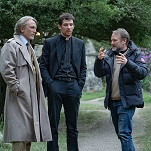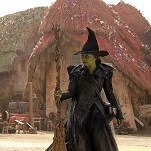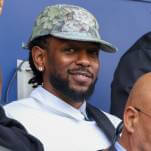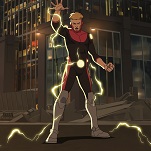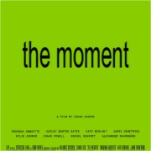Over his nearly 40-year solo career, Bruce Springsteen has established a reputation as a persnickety sort, prone to fussing over tracklists and band personnel and even stage patter. So what are Boss fans to think when they see a man so fiercely in control of his own image releasing an album with a cover like this?
From the distressed font to the sickly color tint to the celestial backdrop, this cover screams “local singer-songwriter with access to Photoshop,” not “certified rock legend.” And what’s with Springsteen’s downcast eyes? Is he supposed to be floating in the night sky, granting wishes? For that matter, what’s with the album title? It’s Springsteen’s least evocative since Human Touch. (Of course one could argue that the goofy title and cover reflect the songs inside; which I sort of do in my review today.)
These four covers, for example, are about as good as it gets. Born To Run captures Springsteen on his way out of the East Coast club circuit and on his way into concert halls and arenas, and everything about the cover—from the playful pose to the crisp black-and-white photography—is in service of legend-building. Darkness On The Edge Of Town, by contrast, finds Springsteen stepping away from the operatic and towards a more commonplace disillusionment, so its cover is almost a direct rebuke to Born To Run’s. Here, Springsteen is washed-out and bleary-eyed, either coming home from a too-late night or preparing to step out to do things he’d rather his wife didn’t know about. This same feeling of impending disaster is also evoked by the cover of Nebraska, which is so stark and gray that I had the album in my collection for years before I could make any sense of what the cover image was supposed to depict. The highway, the windshield, the clouds—the composition of it all is practically abstract. But it’s an apt introduction to a collection of hollow-sounding songs about murderers and losers. As for The Rising, it has a tricky cover that only gains resonance after you listen to the album, and hear songs like “You’re Missing,” which reflect the cover’s image of a significant person fading painfully from memory.
These next four covers are basically okay, though I have some qualms about each. Both Greetings From Asbury Park N.J. and Born In The U.S.A. have become fairly iconic, though I find them a little garish. The Ghost Of Tom Joad cover is definitely eye-catching, though the more I look at it, the less it seems to convey. The music on the album may be in the vein of Nebraska, but the cover painting and typography seem to be trying too hard to sell spooky minimalism. And the cover for We Shall Overcome: The Seeger Sessions is noteworthy mainly for not sucking outright, which is unusual for Springsteen album covers in the 21st century.
Perhaps Springsteen was bootlegged so frequently early in his career that he’s been trying to beat the bootleggers at their own game, by picking cover art indistinguishable from gray-market releases. Check out the four official Springsteen live albums, for example. Live/1975-85 is quite striking, but Plugged: In Concert looks like one of those “Historia De La Musica Rock” collections that used to show up in bargain bins back in the mid-‘80s. And Live In New York and Live In Dublin are both cop-out covers, heavier on text than image—though the silhouette on Live In New York is nice.
Springsteen’s tendency to approve covers that look like boots has spilled over from his live records to his studio albums too. The twin releases of Human Touch and Lucky Town feature decent photos (well, Human Touch does anyway), but the text looks amateurish, like something a concert promoter from some mid-sized metropolis would slap onto a backstage pass. The box set version of Tracks has a strong cover image of the reclining Springsteen, but the way that picture has been thoughtlessly slapped onto the single-disc version screams knock-off. As for Tunnel Of Love, well, like the album itself, the cover art here is a kind of special case: bland on the surface, but stronger than it may seem. Compare the pose on Tunnel Of Love to the pose on Darkness, and compare the overall cover design to the design of Nebraska. This is clearly a repositioning of Springsteen, reintroducing him as a slicked-up dude, while reminding his fans that his ideals and his vision haven’t changed that much. It’s a clever piece of work.
Still, more than anything, Springsteen’s biggest problem is that he’s a little too in love with his own face. From The Wild, The Innocent & The E Street Shuffle onward, Springsteen has frequently seen fit to keep his cover art simple: just a name, a title, and his weathered mug. True, it’s been fascinating to watch that face change over the years—and in the case of a cover like Magic’s, the combination of Springsteen’s worn expression and the album’s title creates an instant ironic effect—but though none of these covers are bad exactly, they do represent a lack of imagination, image-wise. There’s a kind of false humility behind it. (“Nothing fancy, just a big ol’ picture of yours truly.”) Out of all the people that Springsteen has on his payroll, can none of them speak up and question the Boss’s taste? Patti, where are you, hon?
